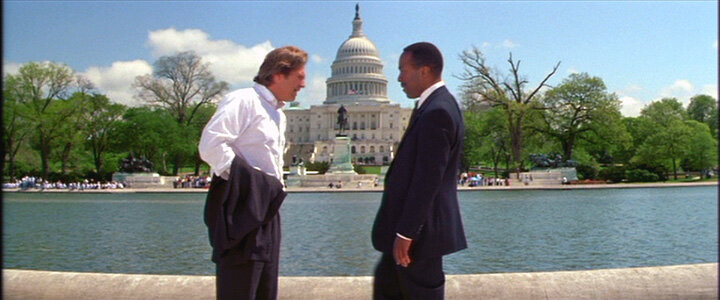Hollywood’s Erasure of Chocolate City
Screencap from Warner Bros.’ Wonder Woman: 1984 (2020), set in Washington D.C.
DC is the capital of the United States, a commuter city of many cultures, and the home to some of the nation’s most profound and pervasive history. However, one of the most stunning phenomena surrounding DC is the complete disconnect between the reality of its citizens and the imagined DC that lives in the minds of non-DC-native Americans.
When asking a non-DC-native to describe the city, their initial response will usually include some childhood memory of a loaded hometown mega bus lumbering through the Smithsonian’s streets or exhausting news soundbites. They may have bitter feelings towards pricey downtown drinks and a relatively confusing red line. But in a city seemingly at the center of the world, with daily global news recognition, how could there be such a profound difference between the imagined DC and the city that Washingtonians know?
One major player in painting this reductive picture of the District is the film industry. This single film list cites 54 blockbuster films based in DC. On this list of famous films many oftentimes all-white casts seemingly live in a city with two metro stops, high-rises, and a city that includes nothing but the White House, the Lincoln Memorial, and the Washington Monument.
“Wonder Woman: 1984” depicts an all-white group of teens in Adidas tracksuits in Marion Barry’s DC, mastering breakdancing in the middle of the Hirschhorn courtyard. In the 1987 film No Way Out, Kevin Costner runs out of the Pentagon through Georgetown, boards a fictional Georgetown metro stop, and then ends up at the Pentagon City Mall. In the 2003 film Head of State, Chris Rock’s character as the first Black president never once visits U Street.







These small inconsistencies aside, films and shows like “Veep”, “Captain America”, “West Wing”, the Michael Bay cinematic universe, and the countless iterations of presidential biopics depict a cold and homogenized DC that does exist, but only to a handful of people.
DC is comprised of rich Black culture and history that extends beyond Pennsylvania Ave. Nicknamed Chocolate City, DC hasn’t had a non-Black mayor in office since the ‘70s. Behind English, due to the heavy influx of immigrant populations, Amharic, Vietnamese, and Arabic are all commonly spoken languages within the city. The city is so bursting with vibrance that a single Metro PCS location is a cultural staple for go-go music. DC has brown leather Chelsea boots and G Shock watches running late for work, but it also has a Black Israelite group shouting at you at any given metro stop, a cursed New York Ave Wendy’s, and go-go remixes of nearly any song you could imagine available on CD (cc: “Hello” (Adele Cover) GoGo Version).
DC is culturally rich, but the long-held disconnect between citizens ’ lived experience and what is depicted on television acts as a threat against preserving the warmth and character of what the District really is. When non-DC-natives don’t see representations of the Black, brown, and queer faces, the city’s loud original music, and its rapping Chinatown six-year-olds, there is no way to humanize DC from afar. There is no way to understand the impact of tearing down significant neighborhoods and building new apartments and Whole Foods. There is no way to realize that banging on an upturned construction bin is more culturally DC than setting foot anywhere near the White House. There is no way to truly comprehend the impact of the January 6 coup-attempt on the children, small businesses, and poor and marginalized people that called DC home before temporary politicians, or even the president.
Cinema needs to empower and uplift the true face and feel of Washington, DC. The 2020 film “Residue”, directed by DC-native Merwai Gerima, strongly highlights the impact of gentrification and the clash between the native and the perceived culture of the city. It is essential to see the reality of DC in film to humanize the city in the minds of the rest of the nation, and prove that it is a cultural hub and home far more rich and expansive than three government buildings and a presidential motorcade.

